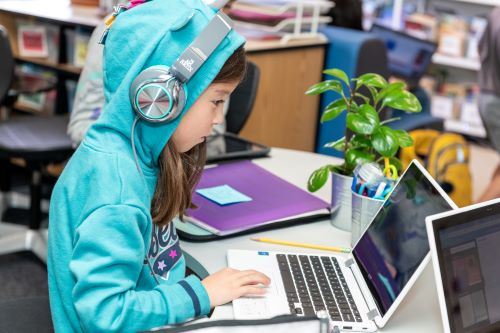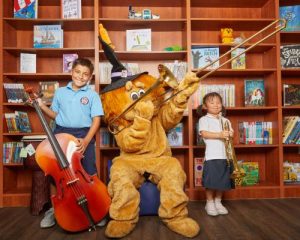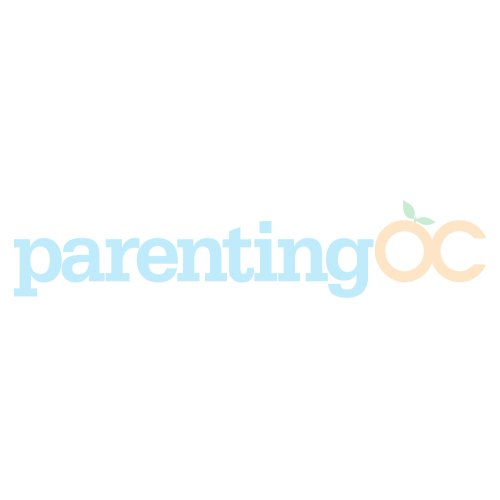
Gone Virtual: Orange County distance learning experts share advice for helping students thrive.
Gov. Gavin Newsom had not yet finished his July 17 briefing when Corinne Mosqueda, a teacher in the Fullerton School District, got the first text message.
Newsom’s announcement that counties on California’s COVID-19 watch list — including Orange County — would not start their school year with in-person instruction or hybrid models but with distance learning only, sent some parents into panic mode. A friend and parent reached out to Mosqueda via text asking if she knew of any student teachers who would be willing to work with her kids.
“I understand the challenging position parents are in,” said Mosqueda. “Especially if they are balancing helping their student have a successful academic year and working full time.”
Many parents got familiar with such challenges in the spring, when distance learning seemed temporary. But the continuation of distance learning has many parents reaching out for a lifeline.
Fortunately, there are some institutions in Orange County that have been using technology to teach remotely even before the coronavirus came along, and they are happy to help.
“At first TutorNerds exclusively offered in-person tutoring,” said Adam Sadri, CEO and academic director at the Irvine-based tutoring facility. “However, a few years ago we developed and launched our own online tutoring platform. With tutornerd.com students get access to the same high-caliber, expert tutors, but sessions occur online in our proprietary lesson space. … Obviously this has been a big benefit for students and families during the COVID-19 situation.”
Sadri began TutorNerds almost 10 years ago when he tutored seven of his own students on a weekly basis after graduating from college. Today, he has 75 professional tutors and consultants on his team.
“By mid-March we knew that our students would need to transition to online tutoring,” Sadri said. “We were fortunate to already have our online tutoring platform. Because the platform’s virtual lesson space has a bunch of teaching tools — video chatting, a virtual whiteboard, document editing, etc. — tutors could continue to work with students.”
Sadri said TutorNerds didn’t notice an increased interest in tutoring services back in March, but there has been an uptick for fall.
“Parents have been reaching out looking for solutions to help their kids have a successful fall 2020 academic semester,” Sadri said. “Parents are also currently interested in implementing small private in-person classes and one-on-one in-person tutoring, in addition to online tutoring.”
Using tutoring services in conjunction with a student’s regular curriculum is an option that Sadri says has many benefits.
“Firstly, expert tutors can re-teach the material from regular class. This will reinforce what the student already knows and fill in any gaps in knowledge,” Sadri said. “Secondly, students can get ahead and be more organized. Almost no student does this on his/her own. With a tutor, students can preview new material and prepare for quizzes and tests ahead of time. Thirdly, a tutor takes the stress out of school.”
In the higher learning realm, Coastline College in Fountain Valley has been educating from a distance for almost 40 years and even has a 100 percent online library.
“One of the silver linings of COVID and all of us having to go online is folks recognizing how substantial and robust online learning can be,” said Dr. Kate Mueller, Coastline’s VP of student services. “It is a viable option.”
Before COVID, Coastline was already using Canvas, a learning management program similar to Blackboard, where faculty members are able to put their entire course online. Counselors who do academic advising were using a program called Cranium Cafe, which is similar to Zoom, with more features for multiple screen sharing and pulling up documents. Zoom was also being used pre-COVID for things like virtual office hours and committee meetings.
“Everyone and their dog is on Zoom now, literally,” Mueller said. “We had already started using Zoom before for our meetings because normally we are a distributed college, meaning we have four different sites where people are working.”
Coastline’s library is also completely online and run by Library Director Elizabeth Horan.
Horan has a unique background that lends itself to creating, managing and maintaining an online library. Her undergraduate degree is in photography and digital imaging and an interest in the preservation of photographs led her to consider working as an archivist, which required a degree in library sciences. Once she got her library sciences degree, she worked at Saddleback College as their distance learning librarian for about seven years and obtained a master’s degree in instructional distance learning from Saddleback. Her concentration was adult learning theories and how people learn in online environments. As a result, she has a deep understanding of how online resources can work to the advantage of the student.
“Our library is always open,” Horan said. “So for example when a student has a question, they can call us, they can text us, they can email us. If they want, we can meet with them via Zoom. … I show them that the physical door is not the only door to the resources that we have.”
And those resources range from online books and collections of journal articles to magazine articles, newspaper articles and multiple sources that support students in their learning.
Horan also helps supplement instruction for classes.
“The library will a lot of times create teaching workshops online about things like, ‘How Do You Avoid Plagiarism’ or ‘How Do You Find Articles,’” Horan said.
These online workshops are housed in Canvas and faculty will assign library workshops as an assignment for their class.
“So students will enroll in it, it maybe takes an hour,” Horan said. “So that’s another way the library is doing instruction.”
Horan also uses YouTube to answer questions she knows a student will have.
“We have a pretty robust YouTube channel and a lot of those videos get embedded in specific classes,” said Horan.
Most of the videos are short (no longer than two minutes) and feature Horan herself covering topics like “How to Embed Images in Canvas from Library Databases.”
“I try to think of as many ways I can answer a question before a student has it,” she said.
If you are looking for ways to use technology more efficiently in your student’s learning, Horan recommends consciously realizing what kind of learner they are.
“It would be very beneficial to think about, ‘What is the best way that I learn?’” she said. “‘Do I learn by reading? Do I learn by watching someone else do it? Do I learn by doing it myself?’ And by identifying those things, that student would then be able to supplement their own learning. I think it’s really important for students to find ways to empower their own learning.”

It also helps when institutions are tech-ready, the way Fullerton Joint Union High School District was. FJUHSD has had a 1:1 Chromebook program for all staff and students for five years as well as technology training.
“All of the students at FJUHSD are provided with a Chromebook when they start their freshman year and keep this Chromebook until they graduate,” said Weston Baughn, FJUHSD’s director of technology. “This along with the many online platforms we use on a daily basis helped our teachers transition into distance learning.”
Of course, they weren’t without their challenges.
“Challenges were ensuring all students had access to WiFi,” said Dr. Karl Zener, FJUHSD’s executive director of administrative service. “We provided routers to all families who requested one.”
The effort paid off.
“Those hotspots along with the Chromebooks every student has made the distance learning feasible in every household,” said Baughn.
This year, they plan to continue with the 1:1 Chromebook program and expand their technology too.
“We have provided every teacher with a Logitech streaming camera for their classroom to provide high quality video and audio,” said Zener.
For those tackling distance learning again this year, Baughn said it’s important to think beyond just computers.
“Technology is no longer a term used just to indicate a computer or device, technology can now be used anywhere in the world and at any time,” he said. “Our district has many online platforms we use to not only provide textbooks for students to use virtually but additional resources and videos created by teachers so students can learn any time of the day.”
Baughn also stresses maintaining openness.
“I would say the most important aspect of transitioning to online is acceptance and flexibility,” he said. “The transition is not easy but if the staff and students are willing to push through the changes, you will find success.”
Some public schools have been online since their inception, like Tustin Connect in the Tustin Unified School District.
Tustin Connect is an online blended learning program where students receive instruction at a tuition-free public school. Tustin Connect serves K-12 students while giving them the flexibility to learn and progress in their own individual time.
“We offer a blend of in-person live instruction with independent study,” said Erick Fineberg, principal at Tustin Connect. “Our teachers provide curated content from across multiple platforms to ensure students are receiving quality instruction with the flexibility to work at their own pace and time.”
The blended learning model affords students the opportunity to continue to build the communication and collaboration skills necessary in today’s world through both in-person meetings and virtual live instruction with teachers and peers for four hours a week. Normally, students have weekly 1:1 in-person meetings with their teachers in addition to the mandatory virtual live sessions, but the current format is 100 percent virtual due to the pandemic.
“The structure varies from elementary to middle to high school, but the basic premise of independent learning is teacher live sessions four hours a week, and 1:1 meetings,” Fineberg said. “Each high school teacher works closely with 30 students in a quasi-counselor role to track progress, support critical executive functioning skills, and ensure students’ needs are being met.”
Fineberg said this environment mirrors higher learning and the workplace. The flexible nature of the school also provides the opportunity for students to pursue their passions outside of the classroom.
“With the flexible schedule, an ice skater can take advantage of ice time in the middle of the day, an actress/actor can attend a casting call without risk of missing valuable class time,” he said.
Tustin Connect also doesn’t experience some of the equity issues that other districts experience. Fineberg credits this to the Tustin community for supporting the addition of technology into the classrooms by approving a bond, Measure S, about seven years ago.
“The measure put 1:1 devices in students’ hands and we have been teaching and learning with technology resources for a while … 100 percent of our K-12 students have a high quality device if they want it. K-8 have iPads that are never more than four years old and our 9-12 students have Microsoft Surface Pros. Additionally, any families that need Internet access receive a hotspot free of charge,” Fineberg said. “We are dialed in at Tustin Unified School District.”
This year’s graduating class was Tustin Connect’s second. The diverse group of students are heading to four-year colleges, community college and the workforce.
“I can say with 100 percent confidence they are certainly no less prepared than their traditional school peers and certainly have proven to be successful in a model that really mirrors the college world and workforce,” he said.
Fineberg said using educational technology isn’t about the technology itself — it is about the people.
“A critical role for technology is to gain access. The technology doesn’t do the teaching, but it is a great tool for learning,” he said. “The technology can be used to connect and collaborate with teachers and peers. It can differentiate curriculum, provide remediation and/or acceleration when utilized properly. Additionally, technology can bring things to life and being computer literate is a critical skill in and of itself.”
And when led by the right instructor, online learning can be just as rigorous as standard, in-person instruction.
“The misnomer that many people have is that the instructors become less critical or de-emphasized in an online environment. That could not be further from the truth,” he said. “A successful program, one that develops strong relationships with its students while providing a rigorous engaging curriculum, is going to be all about the instructor. Our teachers are second to none. They make Tustin Connect awesome and so successful.”
If you’re struggling with distance learning at home with your own student, you might take a cue from Tustin Connect’s blended approach.
“Keep an eye on the screen time,” Fineberg said. “Be conscious of how much time you are asking students to be on a screen and make sure you are providing breaks and alternative activities including collaboration with peers and direct communication with their teachers. Online doesn’t mean impersonal.”
Online also doesn’t mean impossible.
“Stay connected,” said Mosqueda. “Teachers will most likely be communicating weekly learning objectives/information to parents and students through email or some other platform … make sure to check messages daily.
“And if you have questions, do not be afraid to ask your child’s teacher for help.”
Related Posts:
- Impact: What Transitioning to the “New” Normal Means in Education
- At-Home Learning for the Working Parent
- Keeping Children Safe Online During COVID-19
- Explaining COVID-19 to Young Kids
By Sarah Mosqueda
(Photos courtesy of John Garrett)







Leave a Reply